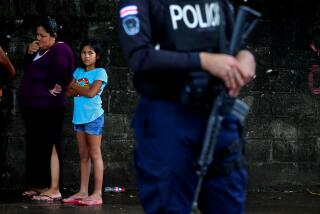Big Costa Rica Debt Too Small to Sway Creditors
SAN JOSE, Costa Rica — Contrary to conventional wisdom, Central Bank President Eduardo Lizano says, when it comes to foreign debt, “small is not beautiful.”
Costa Rica’s $4-billion foreign debt is unwieldy for a small country, although it is just a fraction of what is owed by Brazil, Mexico and other countries capable of making international bankers shake with fright at mention of the word default.
“Costa Rica does not have the leverage of an Argentina or a Mexico,” Lizano said, noting that commercial banks last month denied his government a postponement of interest payments.
Costa Rica is in default on interest payments, as it was in 1981, the year before Mexico sent world bankers into a panic with news that it did not have the dollars to meet debt payments.
One of Highest Debts
On a per-capita basis, Costa Rica’s debt is one of the highest in Latin America, but it is trifling compared to Mexico’s and Brazil’s debts, both of which top $100 billion. Argentina’s debt is close to $49 billion; Venezuela’s is about $31 billion.
Lizano said Costa Rica’s present default is the result of a “cash flow problem.” He said his government was expecting $80 million in loans in the first quarter of the year from the World Bank and the U.S. Agency for International Development. Neither loan came through.
Now, he said, Costa Rica is about $110 million in arrears on interest payments that total about $330 million a year, or more than the country’s annual earnings from meat, sugar and banana exports.
Costa Rican officials and economists are keenly aware of their country’s financial dependence on the United States and U.S.-backed international lending institutions. It is a dependence, some of them say, that makes their economy vulnerable to U.S. political pressure.
“They have the capacity to break the Costa Rican economy if they want to,” a foreign economist said, asking that he not be identified by name.
The issue of economic pressure arose in February, when newly elected President Oscar Arias Sanchez announced that he opposed U.S. military aid to the Nicaraguan rebels, the so-called contras . He said the money would be better spent as aid to U.S. allies in the region.
Arias has since toned down his remarks against aid to the contras, but he still says that Costa Rica will not be drawn into war with Nicaragua. The contras, meanwhile, have been trying to unify their forces and have been hoping to develop a strong southern front that would need Costa Rica as a logistical base.
Some economists and political observers believe that the $40-million loan expected earlier from the U.S. Agency for International Development has been delayed to put political pressure on Arias. But Lizano said that loan problems began before Arias made his statements about the contras.
U.S. officials say the AID loan was delayed because of budget problems in Washington.
The World Bank is demanding that Costa Rica trim government payrolls, cut protective surcharges on imports and reduce the deficit of its National Production Council, which subsidizes and controls prices. Lizano said the government is willing to comply but will reduce the public payroll by attrition over a period of several years rather than all at once.
He said that countries with larger foreign debts are given better terms on their loans. For example, he said, Mexico was recently allowed 14 years for repayment, but Costa Rica was allowed only 9.4 years. Argentina was given 11.5 years, Venezuela 12.5 years. Costa Rica was required to pay a commission of 1%, although Argentina had to pay only .15% and Mexico and Venezuela nothing at all.
Lizano said the banks and international organizations “don’t understand the political and social difficulties” of the steps they insist must be taken.
For 20 years, until the late 1970s, Costa Rica had a strong economy, with 6% annual growth and relatively low inflation and unemployment. A large middle class developed under peaceful and democratic conditions. But in 1978, after oil prices and interest rates had increased sharply, Costa Rica began to finance its relatively high standard of living by borrowing. As unemployment rose, the government increased its hiring.
By 1981, this strategy had produced a crisis, which led to the moratorium on debt payments. The overvalued currency began to decline; the Costa Rican colon fell from 14 to the dollar in December, 1980, to 60 to the dollar by July, 1982. Inflation, which had been about 15% annually, rose to 65% in 1981 and 100% in 1982.
In 1982, a new government pulled the economy out of its downward spiral by reducing government spending, increasing the cost of public utilities and services, and raising taxes. Officials renegotiated the debt.
By last year, the inflation rate was down to 10%, growth was 1.5% and unemployment was 5.5%. This year, lower-than-expected oil prices and higher coffee prices added $200 million to the treasury.
“From a certain point of view, we have overcome the crisis,” Lizano said. “Inflation and unemployment are down. But the overall economic situation is weak. We need structural adjustments. . . . We have become an exporter of capital and can’t increase savings.”
Lizano said he believes that the default on debt payments will be resolved if the $80 million comes through in the AID and World Bank loans.
‘Foreign creditors have the capacity to break the Costa Rican economy if they want to.’
More to Read
Sign up for Essential California
The most important California stories and recommendations in your inbox every morning.
You may occasionally receive promotional content from the Los Angeles Times.










